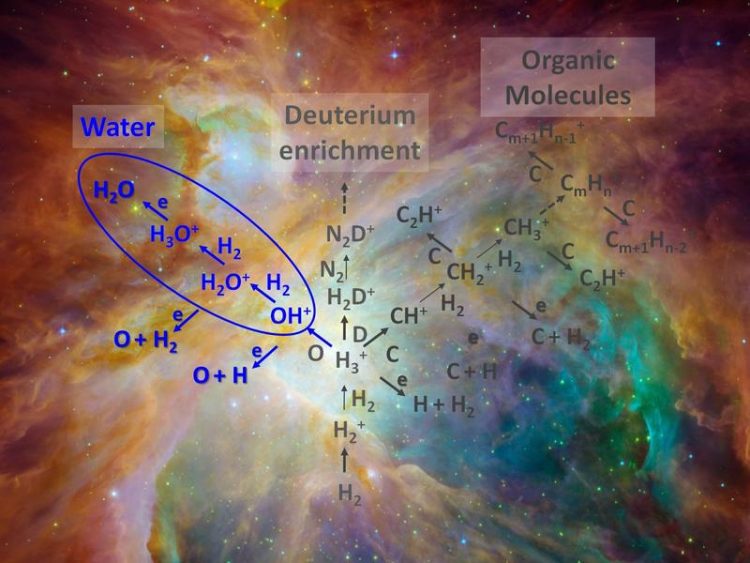Rapid water formation in diffuse interstellar clouds

Simplified interstellar chemistry network, showing the gas-phase water formation chain (blue) in front of the Orion nebula. MPI für Kernphysik / background: NASA
Accumulations of gas and dust in space can be observed with telescopes as interstellar clouds. Despite the low temperatures and densities, a rich variety of molecules has been found in these environments. The backbone of the cold interstellar chemistry is a network of reactions between charged and uncharged atoms or molecules, so-called ion-neutral reactions.
In today´s universe, ion-neutral reactions in the gas phase can lead to the production of complex molecules, from protonated water (H₃O⁺) to organic compounds. When one of the protonated and therefore positively charged molecules encounters an electron, it can be neutralized and usually breaks up into neutral fragments. This process leads to the formation of neutral molecules in space, ranging from water (H₂O) to more complex species, like alcohol and other organics.
But how effective are these processes? To answer this question, it is crucial to find out how often a collision between the reaction partners at low temperature actually leads to a chemical reaction, because collisions are rare in the thin medium. To shed light on these processes, laboratory experiments have to be performed under true interstellar conditions. As these conditions are difficult to realize, present astrochemical models are mostly based on data that have been measured at much higher temperatures and densities, and accordingly are only of limited validity.
Water forms in diffuse interstellar clouds – where reactions on the surface of interstellar dust play a minor role – via a chain of processes started by cosmic rays. Intermediate products are the hydroxyl ion (OH⁺) and the water cation (H₂O⁺), which both react with hydrogen molecules, attaching one hydrogen atom and releasing the other one. The ERC-funded ‘Astrolab’ group of Holger Kreckel at the MPI for Nuclear Physics succeeded to measure the reaction rates of these two important steps in the gas-phase formation of interstellar water at low temperatures.
The scientists trapped the ions in a cryogenic radiofrequency ion trap, in which temperatures down to 10 degrees above absolute zero are accessible. Up to 100 milliseconds after adding a defined amount of hydrogen gas, they determined how many of the initial ions were still present. From the data, they derived so-called rate coefficients for both reactions, which are a measure of the efficiency of the reactions between the collision partners. It turned out that in both cases practically every collision leads to a chemical reaction.
In parallel, colleagues from Cyprus and the USA performed theoretical calculations using a novel method. In an elegant way, this approach employs analogies between quantum systems and the properties of ring-shaped molecules to account for quantum effects which are particularly relevant at low temperatures. The calculated rate coefficients are in excellent agreement with the measured values.
Compared to previous measurements at room temperature, the new values are considerably “faster”. This has implications for the understanding of interstellar chemistry, reaching far beyond the water formation chain. “Our results show once again that it is imperative to use rate coefficients that have been measured under interstellar conditions for astrochemical models“, says Holger Kreckel.
“Since this is experimentally often difficult and time-consuming, it is also important to develop theoretical procedures that can cope with quantum effects which are relevant for low-temperature processes, and to benchmark them with measurements. In this case, the strength of our work lies in the combination of experimental and theoretical methods that are appropriate for interstellar conditions.“
Publication:
Low temperature rates for key steps of interstellar gas-phase water formation
Sunil S. Kumar, Florian Grussie, Yury V. Suleimanov, Hua Guo, Holger Kreckel
Science Advances 4, eaar3417 (2018) doi: 10.1126/sciadv.aar3417
Contact:
Dr. Holger Kreckel
Stored and Cooled Ions Division, Professor. Dr. Klaus Blaum
Max Planck Institute for Nuclear Physics, Heidelberg, Germany
E-Mail: holger.kreckel@mpi-hd.mpg.de
Tel.: +49 6221 516 517
http://www.mpi-hd.mpg.de/mpi/astrolab – Astrolab group homepage at the MPI for Nuclear Physics
Media Contact
All latest news from the category: Physics and Astronomy
This area deals with the fundamental laws and building blocks of nature and how they interact, the properties and the behavior of matter, and research into space and time and their structures.
innovations-report provides in-depth reports and articles on subjects such as astrophysics, laser technologies, nuclear, quantum, particle and solid-state physics, nanotechnologies, planetary research and findings (Mars, Venus) and developments related to the Hubble Telescope.
Newest articles

First-of-its-kind study uses remote sensing to monitor plastic debris in rivers and lakes
Remote sensing creates a cost-effective solution to monitoring plastic pollution. A first-of-its-kind study from researchers at the University of Minnesota Twin Cities shows how remote sensing can help monitor and…

Laser-based artificial neuron mimics nerve cell functions at lightning speed
With a processing speed a billion times faster than nature, chip-based laser neuron could help advance AI tasks such as pattern recognition and sequence prediction. Researchers have developed a laser-based…

Optimising the processing of plastic waste
Just one look in the yellow bin reveals a colourful jumble of different types of plastic. However, the purer and more uniform plastic waste is, the easier it is to…


